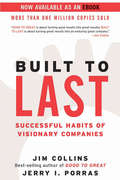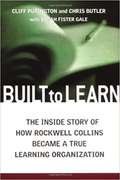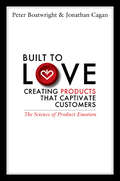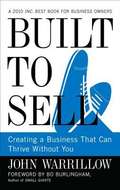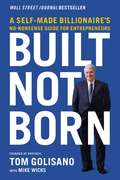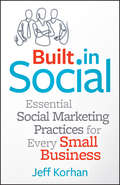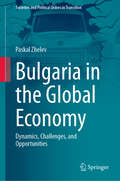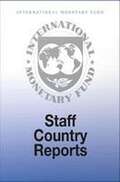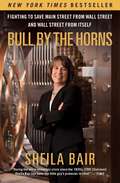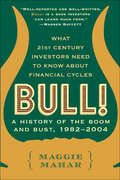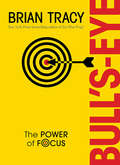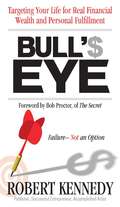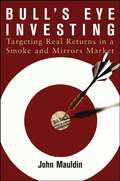- Table View
- List View
Built to Last: Successful Habits of Visionary Companies (Good to Great #2)
by Jerry I. Porras Jim Collins"This is not a book about charismatic visionary leaders. It is not about visionary product concepts or visionary products or visionary market insights. Nor is it about just having a corporate vision. This is a book about something far more important, enduring, and substantial. This is a book about visionary companies." So write Jim Collins and Jerry Porras in this groundbreaking book that shatters myths, provides new insights, and gives practical guidance to those who would like to build landmark companies that stand the test of time.Drawing upon a six-year research project at the Stanford University Graduate School of Business, Collins and Porras took eighteen truly exceptional and long-lasting companies -- they have an average age of nearly one hundred years and have outperformed the general stock market by a factor of fifteen since 1926 -- and studied each company in direct comparison to one of its top competitors. They examined the companies from their very beginnings to the present day -- as start-ups, as midsize companies, and as large corporations. Throughout, the authors asked: "What makes the truly exceptional companies different from other companies?"What separates General Electric, 3M, Merck, Wal-Mart, Hewlett-Packard, Walt Disney, and Philip Morris from their rivals? How, for example, did Procter & Gamble, which began life substantially behind rival Colgate, eventually prevail as the premier institution in its industry? How was Motorola able to move from a humble battery repair business into integrated circuits and cellular communications, while Zenith never became dominant in anything other than TVs? How did Boeing unseat McDonnell Douglas as the world's best commercial aircraft company -- what did Boeing have that McDonnell Douglas lacked?By answering such questions, Collins and Porras go beyond the incessant barrage of management buzzwords and fads of the day to discover timeless qualities that have consistently distinguished out-standing companies. They also provide inspiration to all executives and entrepreneurs by destroying the false but widely accepted idea that only charismatic visionary leaders can build visionary companies.Filled with hundreds of specific examples and organized into a coherent framework of practical concepts that can be applied by managers and entrepreneurs at all levels, Built to Last provides a master blueprint for building organizations that will prosper long into the twenty-first century and beyond.
Built to Learn: The Inside Story Of How Rockwell Collins Became A True Learning Organization
by Chris Butler Cliff Purington Sarah Fister GaleAerospace giant Rockwell Collins typified the old-fashioned corporate approach to organizational learning: lackluster offerings in bland classroom settings, with little connection to the needs of employees or the goals of the company. Enter Cliff Purington and Chris Butler, who in three years transformed Rockwell into a full-fledged learning organization. With a strategy-based and technology-driven learning approach, a 400 percent increase in offerings, 24/7 access for 17,000 worldwide employees, and cost savings of $23 million, Rockwell is lauded and emulated by organizations all over the world. For this vital book, Purington and Butler have organized their revolutionary approach into 10 clear steps that can similarly transform any company. Readers will learn new ways to build relationships, define core learning objectives, present a solid business case, and implement programs and assess their value. Each step offers detailed processes to follow, and explains what worked (and what didn’t), revealing the secrets behind Rockwell’s stunning transformation.
Built to Love: Creating Products That Captivate Customers
by Jonathan Cagan Peter BoatwrightOffers data-driven proof that products and services appealing to customer’s emotional needs outsell the competition Provides a clear method and set of tools to enable companies to develop high emotion products and services Includes case examples from a wide variety of industries Emotion is the single greatest lever in building enduring relationships with customers—it’s what makes them not just purchase a product or service, but get excited about it. Leading companies do more than produce things that work better. They address their customers’ emotional needs—they make them feel better. But this isn’t something you can add on after the fact. Your products and services must be built to love from the very start. This book shows you how. Peter Boatwright and Jonathan Cagan have worked on product and brand strategy with market leaders like Apple, Whirlpool, International Truck, PG&E, and many others. They’ve found that to really connect with customers emotions must be generated by the product itself, not simply tacked on through advertising. And they prove the bottom-line value of product-driven emotion by analyzing the stock performance of companies that sell high-emotion products and through data that show people are willing to pay more for products with emotionally-rich features. After showing that authentic product emotion really does pay off, they move on to how—how emotion can be broken down into its core building blocks, how it is then used to develop new products and services, and how product touchpoints —in particular visual touchpoints — deliver those emotions. Engaging case studies from a variety of industries will help you understand how to integrate emotion into your products and services, regardless of the nature of your business. Emotion is fundamental to all that is human, including the products we enjoy. Built to Love will help you gain loyal, even fanatical customers by going beyond mere efficiency and speaking to their deepest needs and wants.
Built to Meet Needs: Cultural Issues in Vernacular Architecture
by Paul OliverThe study of vernacular architecture explores the characteristics of domestic buildings in particular regions or localities, and the many social and cultural factors that have contributed to their evolution. In this book, vernacular architecture specialist Paul Oliver brings together a wealth of information that spans over two decades, and the whole globe. Some previously unpublished papers, as well as those only available in hard to find conference proceedings, are brought together in one volume to form a fascinating reference for students and professional architects, as well as all those involved with planning housing schemes in their home countries and overseas.
Built to Sell: Creating a Business That Can Thrive Without You
by John WarrillowWhen you start a business, it’s natural to dream of selling it one day. In fact, more than half of America’s 27 million business owners now say they want to sell their business in the next 10 years. You may want to retire, travel, cash out, or just sleep well at night knowing you could sell your business. Unfortunately, just 1 out of every 100 business owners is successful in selling their company each year. To sell your business you need to know: #149; The 3 biggest mistakes business owners make when selling #149; The 8 steps to creating a sellable company #149; How to attract multiple strategic bidders for your business #149; How to maximize your valuation and get the highest possible price for your business #149; The secret to getting your cash up front and avoiding a lengthy earn out Built To Sell: Turn Your Business Into One You Can Sell will show you how to start, grow and profitably exit a business. "John does a masterful job in Built To Sell of illuminating the qualities that business buyers look for in a company" - Bo Burlingham Editor-at-large, Inc. Magazine and bestselling author of Small Giants, The Knack, The Great Game of Business and A Stake In The Outcome.
Built, Not Born: A Self-Made Billionaire's No-Nonsense Guide for Entrepreneurs
by Tom Golisano Mike WicksNo-nonsense lessons on what it takes to build a successful business."If you are an entrepreneur or owner with a burning desire to do better, this is one book you need to get." - Small Business TrendsTom Golisano understands the fears, risks, and challenges small-business owners face every day—he&’s lived it. He has launched and grown his own highly successful businesses and mentored dozens of entrepreneurs, helping them build their own successful companies.Built, Not Born shows readers:How going against the grain can be a great strategy for finding business opportunities and why it pays to question conventional wisdom.Why the pregnant pause can be an effective weapon in negotiations and when interviewing potential employees.Why a prenuptial or even a postnuptial agreement is critical to any business owner.What potential buyers and funding sources look for, and the best way to present a business plan.And finally, the key growth and leadership strategies that have helped Paychex sustain its incredible level of growth and profitability.
Built-In Social
by Jeff KorhanHow to redesign your business for social relevance and profitable successMarketing today is driven by the customer. The old mindset was finding customers for your products and services. The new one is collaborating with the customers whose trust you have earned to develop better products and services for them. Businesses that succeed today acknowledge that they are in shared relationships with customers, employees, and other influencers in the community--even competitors. Built-In Social provides a step-by-step approach to building a business channel that aligns your business with its ideal customers and ensures your organization's continued relevance and success. Intended for mainstream businesses that want to get results from social media networking and marketing but have been frustrated by the obstacles, namely, the lack of a basic method or structure (and a practical step-by-step approach) for converting relevant social qualities into profitable outcomesAuthor Jeff Korhan is a speaker, trainer, and coach helping mainstream small businesses increase their influence, enhance customer relationships, and accelerate growthBuilt-In Social will show you how to turn visibility, authenticity, accessibility, community, and relevance into measurable and profitable gains.
Bulb (A): Foundation
by John R. Wells Benjamin WeinstockThis is the first case in a three-case series on Bulb Energy Ltd. It is followed by "Bulb (B): Launch" (719-441) and "Bulb (C): Rapid Growth" (719-442). It describes the foundation of Bulb, a renewable energy supplier entering the highly competitive UK market in August 2015. Founders Hayden Wood and Amit Gudka were hoping to capitalize on the hundreds of thousands of customers switching their energy provider each month, by promising excellent customer service, a simple, low-price tariff, 100%-renewable electricity, and services to reduce energy consumption. At the time there were only about 250,000 households on renewable tariffs, typically paying a high price for the privilege. Gudka and Wood were convinced that many more households would opt for renewable energy and turn it into a mainstream product if prices were more reasonable. Their goal was to sign up more than 23,000 properties by March 31, 2017 to reach breakeven, and then grow to more than 69,000 properties by March 31, 2021. On Friday August 21, 2015, Gudka and Wood sent out a batch of 1,400 emails to friends and family, encouraging them to switch to Bulb. They waited anxiously for the first sign-ups.
Bulb (B): Launch
by John R. Wells Benjamin WeinstockThis is the second case in a three-case series on Bulb Energy Ltd. It comes after "Bulb (A): Foundation" (719-440) and is followed by "Bulb (C): Rapid Growth" (719-442). It describes the launch of Bulb, a renewable energy supplier entering the highly competitive UK market in August 2015. By the end of March 2017, Bulb had grown to supply 29,311 properties, well ahead of its Launch Plan of 23,166 and beyond the point of breakeven. It had been a slow start, and growth had been volatile, reaching a rate of over 3,000 new members per week at one point, putting severe strains on service levels. Founders Hayden Wood and Amit Gudka had been forced to change many aspects of their plan and defer launching value-added services to help customers reduce energy consumption and create Bulb's vision of distributed generation. Now, the company was generating profits; enough to grow, but not at the level of the original plan. Should the founders scale back on their growth ambitions and delay adding services until they had reached the scale to support them? Or should they seek more funding and accelerate growth?
Bulb (C): Rapid Growth
by John R. Wells Benjamin WeinstockThis is the third case in a three-case series on Bulb Energy Ltd. It follows "Bulb (A): Foundation" (719-440) and "Bulb (B): Launch" (719-441). After a wild and volatile year, Bulb, a new entrant in the UK residential energy market, ended March 2018 with 329,127 properties, 1.2% of the total residential energy market. This was 150% ahead of a plan for 130,000 properties and almost ten times the size the founders, Amit Gudka and Hayden Wood, had imagined in August 2015 when they first launched. Bulb was now one of the top 12 energy suppliers in the UK. Gudka and Wood were convinced that if they reinvested all their profits in growth, they would reach 500,000 properties by March 2019, and reach more than 1 million by March 2021. This would mean postponing the launch of a range of value-added services they had included in their original Launch Plan, but it could make Bulb number 7 in the industry and the first real challenger to the UK's "Big Six" leading energy suppliers to pass the one million-member mark. Was it time to seek more funding to really challenge the Big Six, making renewable energy mainstream? And did it make sense to delay value-added services to support energy conservation, distributed generation, and the switch to electric vehicles, or should they seek funding to support these initiatives too?
Bulb 2015: Foundation
by John R. Wells Benjamin WeinstockThis is the first case in a three-case series on Bulb Energy Ltd. It is followed by "Bulb (B): Launch" (719-441) and "Bulb (C): Rapid Growth" (719-442). It describes the foundation of Bulb, a renewable energy supplier entering the highly competitive UK market in August 2015. Founders Hayden Wood and Amit Gudka were hoping to capitalize on the hundreds of thousands of customers switching their energy provider each month, by promising excellent customer service, a simple, low-price tariff, 100%-renewable electricity, and services to reduce energy consumption. At the time there were only about 250,000 households on renewable tariffs, typically paying a high price for the privilege. Gudka and Wood were convinced that many more households would opt for renewable energy and turn it into a mainstream product if prices were more reasonable. Their goal was to sign up more than 23,000 properties by March 31, 2017 to reach breakeven, and then grow to more than 69,000 properties by March 31, 2021. On Friday August 21, 2015, Gudka and Wood sent out a batch of 1,400 emails to friends and family, encouraging them to switch to Bulb. They waited anxiously for the first sign-ups.
Bulb 2017: Launch
by John R. Wells Benjamin WeinstockThis is the second case in a three-case series on Bulb Energy Ltd. It comes after "Bulb (A): Foundation" (719-440) and is followed by "Bulb (C): Rapid Growth" (719-442). It describes the launch of Bulb, a renewable energy supplier entering the highly competitive UK market in August 2015. By the end of March 2017, Bulb had grown to supply 29,311 properties, well ahead of its Launch Plan of 23,166 and beyond the point of breakeven. It had been a slow start, and growth had been volatile, reaching a rate of over 3,000 new members per week at one point, putting severe strains on service levels. Founders Hayden Wood and Amit Gudka had been forced to change many aspects of their plan and defer launching value-added services to help customers reduce energy consumption and create Bulb's vision of distributed generation. Now, the company was generating profits; enough to grow, but not at the level of the original plan. Should the founders scale back on their growth ambitions and delay adding services until they had reached the scale to support them? Or should they seek more funding and accelerate growth?
Bulb 2018: Hypergrowth
by John R. Wells Benjamin WeinstockAfter a wild and volatile year, Bulb, a new entrant in the UK residential energy market, ended March 2018 with 329,171 properties, 1.2% of the total residential energy market). This was 150% ahead of a plan for 130,000 properties and almost ten times the size the founders, Amit Gudka and Hayden Wood, had imagined in August 2015 when they first launched. Bulb was now one of the top 12 energy suppliers in the UK. Gudka and Wood were convinced that if they reinvested all their profits in growth, they would reach 500,000 properties by March 2019, and reach more than 1 million by March 2021. This would mean postponing the launch of a range of value-added services they had included in their original Launch Plan, but it could make Bulb number 7 in the industry and the first real challenger to the UK's "Big Six" leading energy suppliers to pass the one million-member mark. Even so, Bulb would still be less than 40% of the size of the smallest member of the Big Six and one sixth the size of the leader, British Gas. Was it time to seek more funding to really challenge the Big Six, making renewable energy mainstream? And did it make sense to delay value-added services to support energy conservation, distributed generation, and the switch to electric vehicles, or should they seek funding to support these initiatives too?
Bulb 2018: Rapid Growth
by John R. Wells Benjamin WeinstockThis is the third case in a three-case series on Bulb Energy Ltd. It follows "Bulb (A): Foundation" (719-440) and "Bulb (B): Launch" (719-441). After a wild and volatile year, Bulb, a new entrant in the UK residential energy market, ended March 2018 with 329,127 properties, 1.2% of the total residential energy market. This was 150% ahead of a plan for 130,000 properties and almost ten times the size the founders, Amit Gudka and Hayden Wood, had imagined in August 2015 when they first launched. Bulb was now one of the top 12 energy suppliers in the UK. Gudka and Wood were convinced that if they reinvested all their profits in growth, they would reach 500,000 properties by March 2019, and reach more than 1 million by March 2021. This would mean postponing the launch of a range of value-added services they had included in their original Launch Plan, but it could make Bulb number 7 in the industry and the first real challenger to the UK's "Big Six" leading energy suppliers to pass the one million-member mark. Was it time to seek more funding to really challenge the Big Six, making renewable energy mainstream? And did it make sense to delay value-added services to support energy conservation, distributed generation, and the switch to electric vehicles, or should they seek funding to support these initiatives too?
Bulgaria in the Global Economy: Dynamics, Challenges, and Opportunities (Societies and Political Orders in Transition)
by Paskal ZhelevThis book presents an in-depth analysis of Bulgaria's integration into the global economy, analyzing the evolution, current status, and prospects for the country&’s positioning in the ever-complex system of international economic relations. The book provides a comprehensive examination of Bulgaria's economic trajectory from its historical development to its current role in the global economy. Presenting important periods throughout Bulgaria's economic evolution, including the planned economy era and the subsequent transition to a market-oriented system, the work analyzes the profound shifts and challenges faced by the country. The book examines the integration into the European Union, assessing both the benefits and risks associated with this pivotal relationship. Furthermore, it investigates Bulgaria's foreign economic partnerships, analyzing its interplay with major actors such as the USA, China, and Russia. Systematically exploring foreign trade in goods and services, participation in global value chains, foreign direct investment trends, and the complex dynamics of international labor migration, the book is based on rich empirical data and comparative analyses with similar economies. It addresses emerging trends, with dedicated chapters on green transition, technological advancement, and digital transformation. Finally, the book presents policy implications derived from Bulgaria's experiences and concludes with a forward-looking perspective on enhancing Bulgaria's global economic competitiveness, making it relevant to both academic audiences and policy practitioners.
Bulgaria: 2007 Article IV Consultation--Staff Report; Public Information Notice on the Executive Board Discussion; and Statement by the Executive Director for Bulgaria
by International Monetary FundA report from the International Monetary Fund.
Bulgaria: Selected Issues (Imf Staff Country Reports #No. 14/24)
by International Monetary Fund. European Dept.A report from the International Monetary Fund.
Bulgaria: Selected Issues Paper (Imf Staff Country Reports #No. 14/24)
by International Monetary Fund. European Dept.A report from the International Monetary Fund.
Bulgaria: Third Review Under the Stand-By Arrangement and Request for Waiver of Applicability of Performance Criteria--Staff Report; Staff Statement; Press Release on the Executive Board Discussion
by International Monetary FundA report from the International Monetary Fund.
BulkWhiz: Negotiating as a Startup Founder in the UAE
by Alpana Thapar Katherine Coffman Christine L. ExleyThis case follows Amira Rashad as she founds BulkWhiz, a Dubai-based buy-in-bulk grocery delivery platform. Following its launch in September 2017, BulkWhiz experiences rapid growth of 30 percent per month in the United Arab Emirates. Despite this initial success, Rashad finds herself at a critical juncture just nine months later, with a number of internal and external negotiations awaiting her. First, she is eager to convince her Chief Technology Officer to come on-board full-time, and needs to finalize details on his transition and compensation. Second, she is wrestling with how to expand her business beyond the UAE market. Finally, she is seeking series A fundraising, to fuel the company's growth. How should she approach and sequence these negotiations, and what obstacles might loom?
Bull by the Horns: Fighting to Save Main Street from Wall Street and Wall Street from Itself
by Sheila BairNEW YORK TIMES and WALL STREET JOURNAL BESTSELLER The former FDIC chairwoman, and one of the first people to acknowledge the full risk of subprime loans, offers a unique perspective on the financial crisis.Appointed by George W. Bush as the chairman of the Federal Deposit Insurance Corporation (FDIC) in 2006, Sheila Bair witnessed the origins of the financial crisis and in 2008 became—along with Hank Paulson, Ben Bernanke, and Timothy Geithner—one of the key public servants trying to repair the damage to the global economy. Bull by the Horns is her remarkable and refreshingly honest account of that contentious time and the struggle for reform that followed and continues to this day.
Bull!: A History of the Boom and Bust, 1982–2004
by Maggie MaharWhat today’s investors need to know about financial cycles. “Well-reported and well-written, Bull! is a book investors can learn much from.” —Warren BuffetIn 1982, the Dow hovered below 1000. Then, the market rose and rapidly gained speed until it peaked above 11,000. Noted journalist and financial reporter Maggie Mahar has written the first book on the remarkable bull market that began in 1982 and ended just in the early 2000s. For almost two decades, a colorful cast of characters such as Abby Joseph Cohen, Mary Meeker, Henry Blodget, and Alan Greenspan came to dominate the market news.This inside look at that seventeen-year cycle of growth, built upon interviews and unparalleled access to the most important analysts, market observers, and fund managers who eagerly tell the tales of excesses, presents the period with a historical perspective and explains what really happened and why.“Highly readable and insightful . . . makes a devastating case against the contention that the market is almost perfectly efficient.” —The New York Times“Offers individual investors prescriptive data on how to position oneself for the next bull-market cycle, as well as proven benchmarks for evaluating and selecting companies.” —International Herald Tribune“Mahar imparts a forward-looking and worrisome lesson . . . Intriguing reading.” —The Boston Globe
Bull's Eye
by Brian TracyYour aim in life should be to achieve all of the wonderful things that are possible for you. There is no reason for you not to be earning twice as much as you are today, or even five or ten times as much. Your potential is practically limitless, if you could just learn how to utilize it. Clarity, Focus, and Concentration: Three strong, simple attributes needed to hone in your potential and hit the bull's eye! And just as you can develop your physical muscles through hard work and concentration, you can develop your mental muscles through continuous repetition.You have the ability right now to achieve more than you ever have before. Bull's Eye will teach you how to unleash your powers for success and accomplish more in the next few months than many people do in a lifetime.
Bull's Eye
by Robert H. KennedyAs head of a multimillion-dollar publishing empire, Robert Kennedy knows a thing or two about success. In Bull's Eye, he shares not only the secrets of creating personal wealth but also ways to keep it, thrive in the face of downturns and setbacks, and live the life you've always wanted. Kennedy also shares lessons he's learned, including the importance of marketing, why you need to start believing in yourself and simple ways to stop procrastinating and start making a fortune.
Bull's Eye Investing: Targeting Real Returns In A Smoke And Mirrors Market (Little Books. Big Profits Ser. #37)
by John MauldinThe era of buying and holding stocks is gone -- and will not return for some time. Now is the time to learn to target where the market is going to be, not where it has been, so you can invest successfully. Financial expert John Mauldin makes a powerful, almost irrefutable case regarding the future direction of the markets. He then details a new approach to investing that will allow you to adjust to the new reality of investing. You'll consider options beyond traditional stock portfolios as you learn to choose between the stable and secure investments that will enable you to profit in turbulent markets. Buy your copy of this must-read investment roadmap today.
